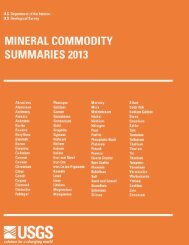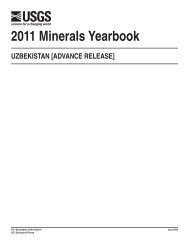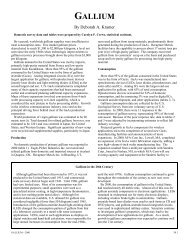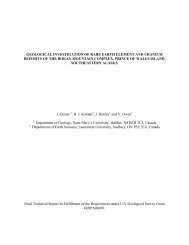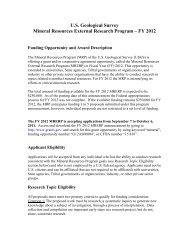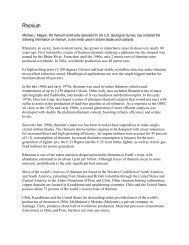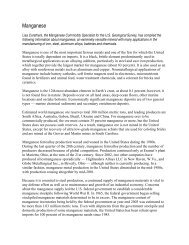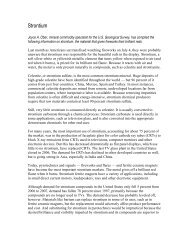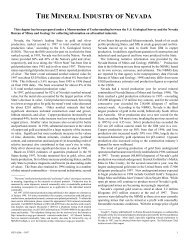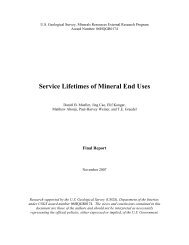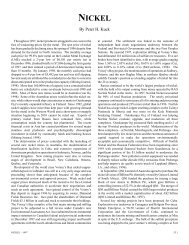MOLYBDENUM Events, Trends, and Issues: U.S. mine output of molybdenum in 2002 decreased an estimated 13% from that of 2001. U.S. imports for consumption decreased an estimated 26% from those of 2001, while the U.S. exports decreased 27% from those of 2001. U.S. reported consumption decreased 17% from that of 2001. Mine capacity utilization was about 40%. World Mine Production, Reserves, and Reserve Base: Reserves and reserve base estimates for Armenia and China have been revised upward based on new information from official country sources. Mine production Reserves 3 Reserve base 3 2001 2002 e (thousand metric tons) United States 37,600 32,600 2,700 5,400 Armenia 3,300 3,000 200 400 Canada 7,000 8,200 450 910 Chile 33,000 34,000 1,100 2,500 China 28,200 28,000 3,300 8,300 Iran 1,600 2,000 50 140 Kazakhstan 230 200 130 200 Kyrgyzstan 250 200 100 180 Mexico 7,000 5,500 90 230 Mongolia 1,500 1,500 30 50 Peru 7,500 9,500 140 230 Russia e 2,600 2,600 240 360 Uzbekistan e 500 500 60 150 World total (rounded) 130,000 128,000 8,600 19,000 World <strong>Resources</strong>: Identified resources amount to about 5.4 million metric tons of molybdenum in the United States and about 13 million metric tons in the world. Molybdenum occurs as the principal metal sulfide in large low-grade porphyry molybdenum deposits and as an associated metal sulfide in low-grade porphyry copper deposits. <strong>Resources</strong> of molybdenum are adequate to supply world needs for the foreseeable future. Substitutes: There is little substitution for molybdenum in its major application as an alloying element in steels and cast irons. In fact, because of the availability and versatility of the metal, industry has sought to develop new materials that benefit from the alloying properties of molybdenum. Potential substitutes for molybdenum include chromium, vanadium, columbium (niobium), and boron in alloy steels; tungsten in tool steels; graphite, tungsten, and tantalum for refractory materials in high-temperature electric furnaces; and chrome-orange, cadmium-red, and organic-orange pigments for molybdenum orange. e Estimated. E Net exporter. 1 Major producer price per kilogram of molybdenum contained in technical-grade molybdic oxide. 2 Defined as imports - exports + adjustments for Government and industry stock changes. 3 See Appendix C for definitions. 115 U.S. Geological Survey, <strong>Mineral</strong> <strong>Commodity</strong> <strong>Summaries</strong>, January <strong>2003</strong>
116 NICKEL (Data in metric tons of nickel content, unless otherwise noted) Domestic Production and Use: The United States did not have any active nickel mines in 2002. Limited amounts of byproduct nickel, though, were recovered from copper and palladium-platinum ores mined in the Western United States. On a monthly or annual basis, 145 facilities reported nickel consumption. The principal consuming State was Pennsylvania, followed by West Virginia, Indiana, and Illinois. Approximately 42% of the primary nickel consumed went into stainless and alloy steel production, 38% into nonferrous alloys and superalloys, 14% into electroplating, and 6% into other uses. Ultimate end uses were as follows: transportation, 32%; chemical industry, 13%; electrical equipment, 10%; construction, 9%; fabricated metal products, 8%; household appliances, 7%; petroleum industry, 6%; machinery, 6%; and other, 9%. Estimated value of apparent primary consumption was $775 million. Salient Statistics—United States: 1998 1999 2000 2001 2002 e Production: Mine — — — — — Plant 4,290 — — — — Shipments of purchased scrap: 1 89,700 93,000 123,000 141,000 145,000 Imports: Ore 1,420 — — — — Primary 148,000 139,000 156,000 136,000 122,000 Secondary 8,500 9,480 10,700 8,760 8,920 Exports: Primary 8,440 7,440 8,150 8,450 7,000 Secondary 35,100 31,400 49,900 48,600 43,200 Consumption: Reported, primary 116,000 116,000 115,000 98,800 84,600 Reported, secondary 63,100 71,000 84,000 101,000 111,000 Apparent, primary 149,000 140,000 147,000 129,000 114,000 Total 2 212,000 211,000 231,000 230,000 225,000 Price, average annual, London Metal Exchange: Cash, dollars per metric ton 4,630 6,011 8,638 5,945 6,776 Cash, dollars per pound 2.100 2.727 3.918 2.696 3.074 Stocks: Government, yearend 2,600 — — — — Consumer, yearend 15,900 10,000 14,300 13,900 12,500 Producer, yearend 3 13,100 12,700 12,300 12,600 12,400 Employment, yearend, number: Mine 7 5 1 — — Smelter and port 7 7 — — — Net import reliance 4 as a percentage of apparent consumption 64 63 56 46 43 Recycling: About 111,000 tons of nickel was recovered from purchased scrap in 2002. This represented about 57% of total reported consumption for the year. Import Sources (1998-2001): Canada, 40%; Norway, 13%; Russia, 12%; Australia, 10%; and other, 25%. Tariff: Item Number Normal Trade Relations 12/31/02 Nickel oxide, chemical grade 2825.40.0000 Free. Ferronickel 7202.60.0000 Free. Nickel oxide, metallurgical grade 7501.20.0000 Free. Unwrought nickel, not alloyed 7502.10.0000 Free. Depletion Allowance: 22% (Domestic), 14% (Foreign). Government Stockpile: The U.S. Government sold the last of the nickel in the National Defense Stockpile in 1999. The U.S. Department of Energy is holding 6,000 tons of nickel scrap contaminated by low-level radioactivity. Events, Trends, and Issues: Stainless steel accounts for two-thirds of the primary nickel consumed in the world. U.S. production of austenitic (i.e., nickel bearing) stainless steel was up 30% from the 1.01 million tons of 2001. The increase occurred after recessionary forces began weakening in mid-2002 and the economic disruption created by the terrorist attacks of September 11, 2001, had partially subsided. Imported steels accounted for 22% of total U.S. stainless steel consumption in 2002, down slightly from 24% for the previous year. On March 5, 2002, the U.S. Government temporarily raised tariffs on some forms of stainless steel. The new tariffs were part of a much larger trade action taken to slow dumping of excess foreign steel products at below market prices. The new tariffs were to decrease annually over 3 years and then drop back down to 2001 levels. Prepared by Peter H. Kuck [(703) 648-4965, pkuck@usgs.gov, fax: (703) 648-7757]



